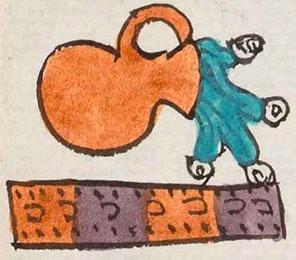Tlaahuililpan (Mdz27r)
This compound glyph for the place name Tlaahuililpan features three elements. One is a ceramic jug for fetching water, another is the water pouring from it, and the third is an agricultural parcel. The jug has a rounded body and a handle; it is painted a terracotta color. The water is the usual turquoise blue with black lines of current and white turbinate shells and white water droplets/beads coming off the little streams or splashes. The horizontal, rectangular, and segmented agricultural parcel has two terracotta colored pieces and two purple pieces. All are textured with dots and sideways u's. The locative suffix (-pan) is not shown visually.
Stephanie Wood
The jar may be an (atlacuihuani), but it is not contributing to the phonetics of the place name. Rather it is showing how the land (tlalli), again, not phonetic, is watered, indicating the verb, tlaahuilia. An irrigated parcel is a tlahuilili, which is also indicated.
Stephanie Wood
tlaahuililpā.puo
Tlaahuililpan, pueblo
Stephanie Wood
c. 1541, but by 1553 at the latest
Stephanie Wood
They jug, the water, and the segmented parcel of agricultural land all have either semantic and/or phonetic value.
tierras, parcelas, agricultura, riego, cantaros, nombres de lugares, ollas, jarras

tlaahuilia, to water something, https://nahuatl.wired-humanities.org/content/tlaahuilia
tlaahuilil(li), an irrigated garden or agricultural plot, https://nahuatl.wired-humanities.org/content/tlaahuililli
-pan (locative suffix), https://nahuatl.wired-humanities.org/content/pan
Codex Mendoza, folio 27 recto, https://digital.bodleian.ox.ac.uk/objects/2fea788e-2aa2-4f08-b6d9-648c00..., image 64 of 188.
The Bodleian Libraries, University of Oxford, hold the original manuscript, the MS. Arch. Selden. A. 1. This image is published here under the UK Creative Commons, “Attribution-NonCommercial-ShareAlike 3.0 License” (CC-BY-NC-SA 3.0).



